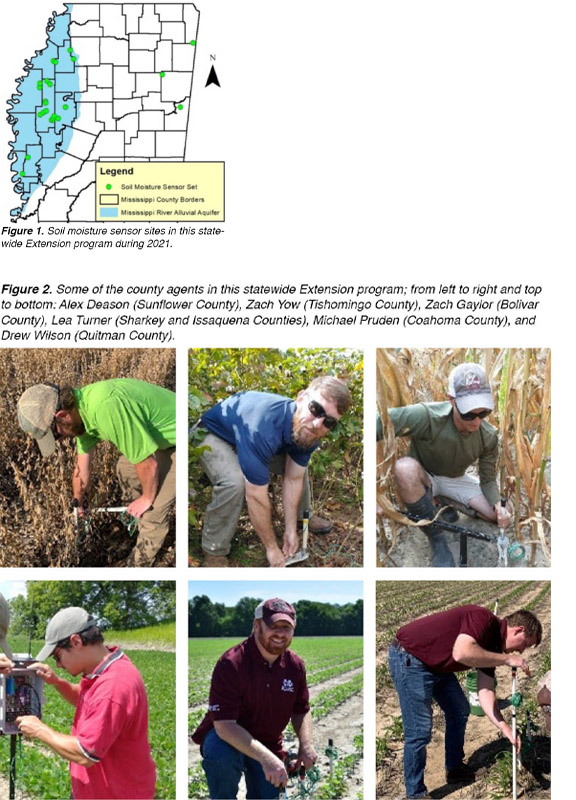Research Project
Advancing Adoption of Soil Moisture Sensors Through On-Farm Training and Demonstration
Investigators: Drew Gholson, Himmy Lo, Alex Deason, Mark Henry, Jacob Rix
Funding Agency: Mississippi Soybean Promotion Board under project 13-2021, by Mississippi Corn Promotion Board under project 03- 2021, and by Cotton Incorporated State Support Program under project 21-863.
Date: 2021
Project Summary
Motivation
Research has shown that soil moisture sensors can help producers irrigate less while maintaining or even improving yield and profit. However, hesitation to adopt soil moisture sensors remains common in Mississippi and nationwide. Some producers assume that their irrigation scheduling is already near optimal and thus will not benefit from the information reported by sensors. Some other producers are reluctant to continue using sensors because of a negative past experience, such as suspicious sensor readings and malfunctioning telemetry systems. In either case, one-on-one guidance from MSU Extension professionals over multiple seasons can assist Mississippi producers in gaining the skills and confidence necessary to adopt soil moisture sensors on their own.
Program
To empower producers to integrate soil moisture sensors fully into their farming operations, we launched an agent-led, multi-year on-farm education program. With generous funding from Mississippi commodity promotion boards and NCAAR, we give telemetry-enabled soil moisture monitoring systems and technical support to interested MSU Extension county agents. These agents recruit producers from their respective counties and provide participants with hands-on training and troubleshooting to deliver the best user experience. Agents then gradually decrease their involvement with day-to-day sensor data interpretation until the participants become active and capable independent users of soil moisture sensors. More than 20 producers across Mississippi participated in 2021, and the crops at the sensor locations included soybean, corn, cotton, and rice. Four of the sensor sites were under sprinkler irrigation while the remainder were surface irrigated (Figure 1).
Outcomes
Some program participants were convinced of sensors’ usefulness so quickly that they bought soil moisture monitoring systems before the first year was over. Some participants ignored the sensors during the first year and were shocked to discover at their end-of-season meeting how much they had over-irrigated. This realization motivated them to pay closer attention to the sensors during the second year. We hope to continue increasing the number of participants to expand the impact of this program. This program also bolstered the professional competence of county agents (Figure 2). Agents deepened their familiarity with installing, maintaining, and removing sensors and telemetry units as well as with setting up and understanding telemetry interfaces. Additionally, agents built stronger relationships with the participants through frequent, year-round communication to coordinate, teach, and advise for this intensive program. These relationships helped agents to advertise and offer other beneficial services and ultimately to serve their communities more effectively.
Project Photos

- Topic:
- Decision
- Irrigation
Find Research
By Crop Type
By Topic
Contact NCAAR
General Information
Kaye Sullivan
vfs23@msstate.edu
662.390.8510
F:662.390.8501
Showcase Demo
Drew Gholson, Coordinator
drew.gholson@msstate.edu
662.390.8505
Himmy Lo
himmy.lo@msstate.edu
662.390.8509

